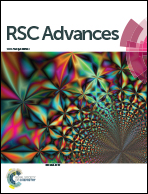One-pot aqueous synthesis of highly strained CdTe/CdS/ZnS nanocrystals and their interactions with cells†
Abstract
In this work, a very simple one-pot synthetic approach was developed to generate aqueous CdTe/CdS/ZnS type-II/type-I red-emitting nanocrystals (NCs). Strain-induced optical properties of CdTe/CdS particles having core(small)/shell(thick) structure with a maximum quantum yield (QYmax) ∼ 57% were further improved with the overgrowth of a ZnS shell, resulting in a core(small)/shell(thick)/shell(small) structure (QYmax ∼ 64%). The spectral properties were tuned further to the near-infrared region as the ZnS shell grew in thickness. X-ray powder diffraction (XRD) analysis and high-resolution transmission electron microscope (HRTEM) images showed the crystalline structure of NCs proving the epitaxial growth of ZnS without crystalline defects. Under continuous UV-irradiation for 5 h, the NCs did not exhibit any photo-degradation but instead displayed a photo-annealing process. These extremely photostable NCs were further characterized in terms of their cytotoxicity and their cell labeling performances. The presence of a ZnS shell was found to reduce the toxicity of the CdTe/CdS NCs. Furthermore, aptamer–conjugated NCs were successfully utilized in targeted cell imaging. Promisingly, the aptamer–NCs bioconjugates were internalized by A549 cells within 2 hours of incubation and retained their fluorescence even after 24 hours of internalization.


 Please wait while we load your content...
Please wait while we load your content...